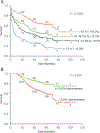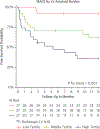Development of Imaging Endpoints for Clinical Trials in AL and ATTR Amyloidosis: Proceedings of the Amyloidosis Forum
- PMID: 39985507
- PMCID: PMC12161488
- DOI: 10.1016/j.jcmg.2024.11.003
Development of Imaging Endpoints for Clinical Trials in AL and ATTR Amyloidosis: Proceedings of the Amyloidosis Forum
Abstract
Light chain amyloidosis and transthyretin amyloidosis are rare protein misfolding disorders characterized by amyloid deposition in organs, varied clinical manifestations, and poor outcomes. Amyloid fibrils trigger various signaling pathways that initiate cellular, metabolic, structural, and functional changes in the heart and other organs. Imaging modalities have advanced to enable detection of amyloid deposits in involved organs and to assess organ dysfunction, disease stage, prognosis, and treatment response. The Amyloidosis Forum hosted a hybrid meeting to focus on the use of imaging endpoints in clinical trials for systemic immunoglobulin light chain amyloidosis and transthyretin amyloidosis. Stakeholders from academia and industry, together with representatives from multiple regulatory agencies reviewed the use of imaging biomarkers with a focus on cardiac amyloidosis, described applications and limitations of imaging in clinical trials, and discussed qualification of imaging as a surrogate clinical outcome. Survey results provided important patient perspectives. This review summarizes the proceedings of the Amyloidosis Forum.
Keywords: amyloidosis; cardiac imaging; clinical trial endpoints.
Copyright © 2025 The Authors. Published by Elsevier Inc. All rights reserved.
Conflict of interest statement
Funding Support and Author Disclosures The Amyloidosis Forum is funded by the Amyloidosis Research Consortium (ARC). ARC is funded through private/philanthropic donations and grants from for-profit pharmaceutical and biotechnology companies. ARC retains all influence, control, and autonomy over projects for which it has received external support. ARC has received grants from Alexion, Alnylam, Attralus, joint funding from AstraZeneca and Ionis, BridgeBio, GlaxoSmithKline, Intellia Therapeutics, Janssen, Life Molecular Imaging, Pfizer, Protego, and Prothena in support of the Amyloidosis Forum Pathways for the Development of Imaging Endpoints meeting. ARC was responsible for designing the meeting, co-developing the meeting agenda, recruitment of speakers, moderators, and panelists, production of meeting materials, hosting the hybrid meeting, and publications. U.S. Government Employee Disclaimer: This paper reflects the views of the authors and should not be construed to represent official views or policies of the U.S. Food and Drug Administration, National Heart, Lung, and Blood Institute (NHLBI), National Institutes of Health (NIH), or the U.S. Department of Health and Human Services. Medicines and Healthcare Products Regulatory Agency (MHRA) Disclosure: The positions expressed in this document are individual opinions and should not be interpreted as agreed positions or policy of MHRA or the UK government. European Medicines Agency (EMA) Disclosure: This paper reflects the views of the authors and should not be interpreted as official positions of EMA, or member agencies, specifically the Bundesinstitut fur Arzneimittel und Medizinprodukte (BfArM), or Agence Nationale de Securite du Medicament et des Produtis de Sante (ANSM). Dr Dorbala has received research grants from Pfizer, Attralus, GE Healthcare, Siemens, and Phillips; and consulting fees from Pfizer, BridgeBio, Novo Nordisk, and MedScape. Dr Alexander has received consulting fees from Alnylam, Arbor Biotechnologies, Bristol Myers Squibb, Intellia, and Novo Nordisk. Dr Brambatti is a shareholder at Ionis pharmaceuticals and employee and shareholder at Merck and Co. Dr Cuddy has received grant support from NIH 1K23HL166686-01 and American Heart Association 23CDA857664; and personal fees from Pfizer, Eidos/BridgeBio, Ionis, AstraZeneca, and Novo Nordisk. Dr Dispenzieri is on the advisory board and independent review committee of Janssen, Oncopeptides, and Sorrento; is on the data monitoring safety committee of Alnylam, Pfizer, and Takeda; and has received research dollars from BMS. Dr Ezzeddine has received research grants from Pfizer Inc; consulting fees from Alnylam Pharmaceuticals and Medscape from WebMD; and intellectual property on AI-enabled amyloid detection from ECG/Anumana, Inc. Dr Falk has received consulting fees from Alnylam and AstraZeneca. Dr Fontana is on the advisory board and/or a consultant for Alexion, Alnylam, Caelum, Intellia, Janssen, Novo Nordisk, Pfizer, Attralus, Lexeo, and Prothena. Dr Grodin has received sources of funding from Texas Health Resources Clinical Scholarship, Pfizer, Eidos/BridgeBio, and NHLBI (R01HL160892); and consultancy fees from Alnylam, AstraZeneca, Intellia Pfizer, Eidos/BridgeBio, and Sarepta. Dr Guthrie is an employee and shareholder of Attralus. Dr Hofling is a U.S. government employee. Dr Lin is an advisory board member for Ionis (Cardio TTransform Trial); and has received research funding for an investigator-initiated trial on TTR amyloid from Pfizer and Biotronik. Dr Masri has received research grants from Pfizer, Ionis, Attralus, and Cytokinetics; and fees from Cytokinetics, BMS, Eidos, Pfizer, Ionis, Lexicon, Alnylam, Attralus, Haya, BioMarin, and Tenaya. Dr Maurer has received grant support from NIH R01HL139671 and R01AG081582-01; grants and personal fees from Alnylam, Pfizer, Eidos, Prothena, and Ionis; and personal fees from AstraZeneca, Akcea, Intellia, and Novo Nordisk. Dr Mittmann is an employee of EMA/BrArM. Dr Quarta is an Alexion/AstraZeneca employee. Dr Race is an employee of EMA/ANSM. Dr Rajendran is a U.S. government employee. Dr Ruberg has received research grants from NIH/NHLBI (HL139671), Alnylam, Akcea/Ionis, and Pfizer; and consulting fees from AstraZeneca. Dr Sanchorawala has received research support from Celgene, Millennium-Takeda, Janssen, Prothena, Sorrento, Karyopharm, Oncopeptide, Caelum, and Alexion; consultant fees from Pfizer, Jansen, and Attralus; and is on the scientific advisory board for Proclara, Caelum, Abbvie, Janssen, Regeneron, Protego, Pharmatrace, Telix, Prothena, and AstraZeneca. Dr Signorovitch is an employee of Analysis Group, Inc, which has received consulting fees from ARC. Dr Sirac has received a research grant from Attralus, Inc. Dr Soman has received institutional grants from Pfizer; and consultancy fees from Pfizer, Anylam, BridgeBio, and Spectrum Dynamics. Dr Sperry has received personal fees from Pfizer, AstraZeneca, Alnylam, and BridgeBio. Dr Stephens is a full-time employee of Life Molecular Imaging, GmbH. Dr Stockbridge is a U.S. government employee. Dr Vest is an employee and shareholder of Alnylam Pharmaceuticals. Dr Wall is an inventor of IP related to iodine (124)I evuzamitide; and is co-founder, shareholder, and chief scientific officer of Attralus, Inc. Dr Wechalekar is on the advisory board/received honorarium from Janssen, GlaxoSmithKline, Prothena, Alexion/AstraZeneca, and Attralus. All other authors have reported that they have no relationships relevant to the contents of this paper to disclose.
Figures









References
-
- Amyloidosis Research Consortium. ARC. Accessed February 20, 2025. www.arci.org
-
- Gertz MA, Dispenzieri A. Systemic amyloidosis recognition, prognosis, and therapy: a systematic review. JAMA. 2020;324:79–89. - PubMed
Publication types
MeSH terms
Substances
Supplementary concepts
Grants and funding
LinkOut - more resources
Full Text Sources
Medical
Research Materials

